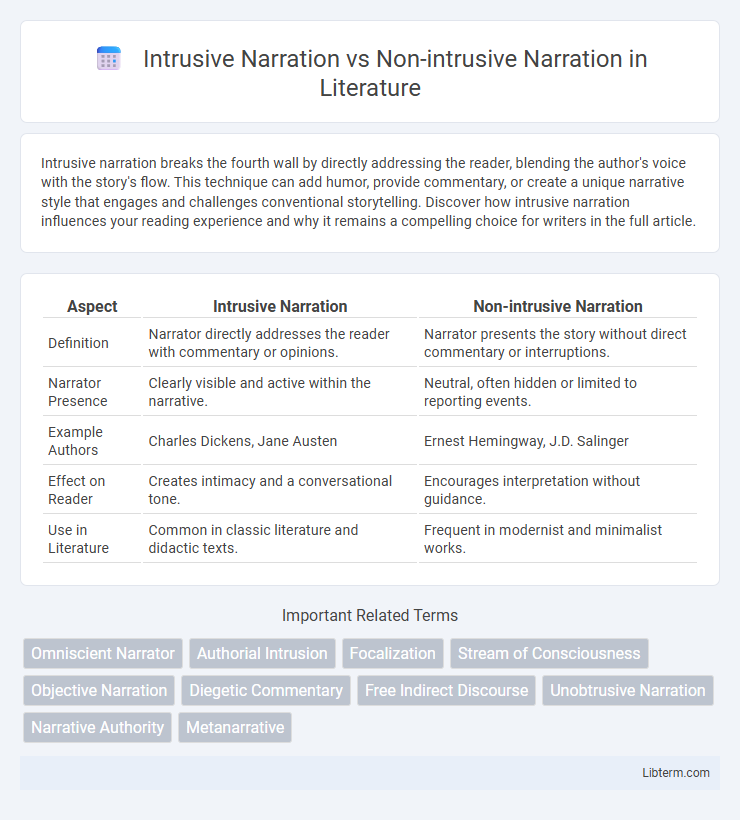Intrusive narration breaks the fourth wall by directly addressing the reader, blending the author's voice with the story's flow. This technique can add humor, provide commentary, or create a unique narrative style that engages and challenges conventional storytelling. Discover how intrusive narration influences your reading experience and why it remains a compelling choice for writers in the full article.
Table of Comparison
| Aspect | Intrusive Narration | Non-intrusive Narration |
|---|---|---|
| Definition | Narrator directly addresses the reader with commentary or opinions. | Narrator presents the story without direct commentary or interruptions. |
| Narrator Presence | Clearly visible and active within the narrative. | Neutral, often hidden or limited to reporting events. |
| Example Authors | Charles Dickens, Jane Austen | Ernest Hemingway, J.D. Salinger |
| Effect on Reader | Creates intimacy and a conversational tone. | Encourages interpretation without guidance. |
| Use in Literature | Common in classic literature and didactic texts. | Frequent in modernist and minimalist works. |
Understanding Intrusive Narration
Intrusive narration occurs when the narrator directly addresses the reader, offering commentary or insights outside the story's events, creating a distinct narrative voice that influences reader interpretation. This technique often breaks the fourth wall, blending subjective opinions with the storyline to guide or manipulate the audience's perspective. Understanding intrusive narration is essential for analyzing authorial intent and the interplay between narrative authority and reader engagement in literary works.
Defining Non-intrusive Narration
Non-intrusive narration immerses readers in the story without the narrator's overt presence, offering an objective, often third-person perspective that allows events and characters to unfold naturally. It minimizes authorial commentary, relying on dialogue and action to convey meaning, enhancing reader engagement through subtlety and restraint. This technique contrasts with intrusive narration, where the narrator frequently breaks the fourth wall to directly address or guide the audience.
Key Traits of Intrusive Narration
Intrusive narration is characterized by the narrator's direct intervention in the narrative, offering personal commentary, opinions, or explanations that shape the reader's perception. This style often breaks the fourth wall, addressing the audience explicitly and guiding interpretation with subjective insights. Key traits include overt narrator presence, judgmental tone, and frequent asides that influence the storytelling rhythm and reader engagement.
Hallmarks of Non-intrusive Narration
Non-intrusive narration is characterized by its objective, unobtrusive presence, allowing the story to unfold through characters' actions and dialogues without direct authorial commentary. It often employs a limited or third-person omniscient perspective that refrains from evaluating or guiding the reader's interpretation, maintaining narrative neutrality. This approach enhances immersive storytelling by prioritizing the reader's independent engagement with the plot and thematic elements.
Narrative Voice and Reader Engagement
Intrusive narration features a prominent narrative voice that directly addresses the reader, guiding their interpretation and enhancing engagement through personal commentary and insights. Non-intrusive narration maintains an impartial narrative voice, allowing readers to immerse themselves in the story without overt authorial presence, fostering a more subtle and immersive engagement. The choice between intrusive and non-intrusive narration significantly influences reader connection by shaping the degree of narrative authority and emotional involvement.
Authorial Presence in Storytelling
Intrusive narration features a prominent authorial presence that directly addresses the reader, guiding interpretation and offering commentary that shapes the story's meaning. Non-intrusive narration minimizes authorial intervention, allowing characters and events to unfold organically without explicit guidance or judgment from the narrator. The contrast highlights how intrusive narration influences reader engagement through overt authorial voice, while non-intrusive narration fosters immersion by maintaining narrative distance.
Advantages of Intrusive Narration
Intrusive narration offers the advantage of providing direct insight into a character's thoughts and motives, creating a deeper emotional connection for the reader. It allows the author to guide the audience's interpretation and emphasize key themes or moral lessons. This style enhances narrative clarity by explicitly addressing the reader and offering commentary that enriches the storytelling experience.
Benefits of Non-intrusive Narration
Non-intrusive narration allows readers to immerse themselves deeply within the story by presenting events and character thoughts without the narrator's overt commentary, enhancing authentic emotional engagement. This narrative style fosters a more natural flow of information, enabling readers to interpret scenes independently and develop stronger personal connections with the plot. By minimizing authorial presence, non-intrusive narration maintains narrative objectivity and supports diverse interpretations, enriching the overall reading experience.
Choosing the Right Narrative Style
Choosing the right narrative style between intrusive and non-intrusive narration significantly impacts reader engagement and storytelling effectiveness. Intrusive narration, where the narrator directly addresses the audience or offers personal commentary, creates a strong authorial presence, ideal for works emphasizing thematic depth or authorial voice, such as in classic novels by authors like Charles Dickens. Non-intrusive narration, favoring an objective or immersive approach without narrator interruptions, suits modern storytelling that prioritizes character experience and plot-driven narratives, commonly found in contemporary fiction and cinematic scripts.
Impact on Storytelling and Reader Perception
Intrusive narration, characterized by the narrator's direct commentary and subjective opinions, shapes storytelling by guiding the reader's interpretation and adding layers of authorial presence, which can deepen thematic understanding but potentially limit imaginative engagement. Non-intrusive narration employs an objective, unobtrusive voice that allows readers to interpret the narrative independently, fostering a more immersive experience and diverse emotional responses. The choice between intrusive and non-intrusive narration significantly influences narrative reliability, reader trust, and the overall tone of the story.
Intrusive Narration Infographic

 libterm.com
libterm.com